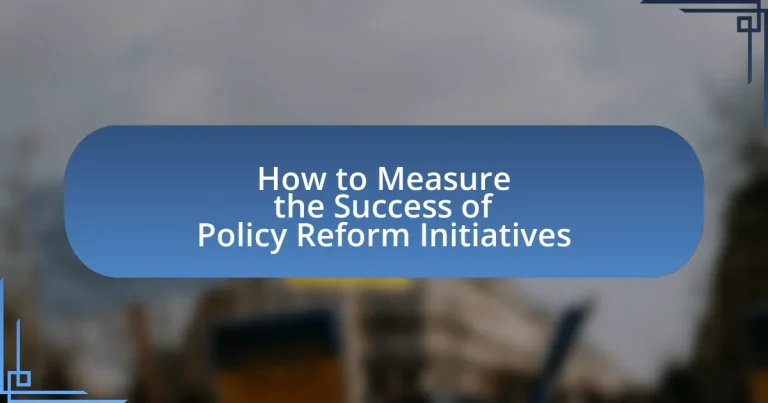Policy reform initiatives are structured efforts aimed at modifying existing policies to enhance their effectiveness and address emerging societal issues. This article examines the impact of these initiatives on society, highlighting their potential to improve public welfare, stimulate economic growth, and promote social equity. Key objectives of policy reform include enhancing efficiency, improving equity, and fostering accountability within governance systems. The article also discusses the importance of measuring success through both quantitative and qualitative metrics, the challenges faced in this measurement process, and strategies to overcome these challenges for effective evaluation of policy reform initiatives.
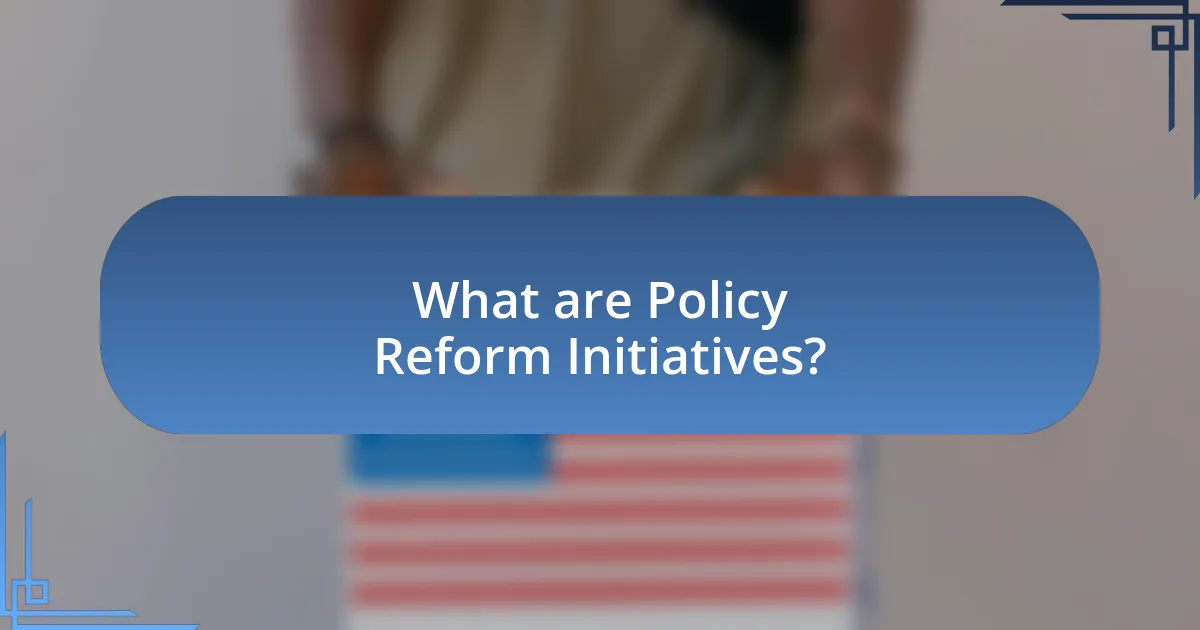
What are Policy Reform Initiatives?
Policy reform initiatives are structured efforts aimed at changing existing policies to improve their effectiveness or address emerging issues. These initiatives often involve comprehensive assessments of current policies, stakeholder engagement, and the development of new strategies to enhance governance and public welfare. For example, the Affordable Care Act in the United States was a significant policy reform initiative designed to expand healthcare coverage and reduce costs, demonstrating the impact such initiatives can have on societal outcomes.
How do Policy Reform Initiatives impact society?
Policy reform initiatives significantly impact society by altering laws and regulations that govern social, economic, and political interactions. These changes can lead to improved public welfare, as evidenced by the Affordable Care Act in the United States, which expanded healthcare access to millions, reducing the uninsured rate from 16% in 2010 to 9% in 2019. Additionally, policy reforms can stimulate economic growth; for instance, tax reforms can incentivize investment and job creation, as seen in the 2017 Tax Cuts and Jobs Act, which aimed to boost the economy by lowering corporate tax rates. Furthermore, successful policy reforms often enhance social equity by addressing systemic inequalities, such as the legalization of same-sex marriage, which has promoted greater acceptance and rights for LGBTQ+ individuals. These examples illustrate that policy reform initiatives can lead to substantial societal changes, improving quality of life and fostering a more equitable society.
What are the key objectives of Policy Reform Initiatives?
The key objectives of Policy Reform Initiatives are to enhance efficiency, improve equity, and promote accountability within governance systems. These initiatives aim to streamline processes, ensuring that resources are utilized effectively, which can lead to better service delivery and reduced waste. Additionally, they focus on creating fair access to services and opportunities for all citizens, addressing disparities that may exist in society. Furthermore, promoting accountability involves establishing mechanisms that hold public officials responsible for their actions, thereby fostering trust in government institutions. Evidence from various studies indicates that successful policy reforms can lead to measurable improvements in economic performance and social outcomes, reinforcing the importance of these objectives.
How do stakeholders influence Policy Reform Initiatives?
Stakeholders influence policy reform initiatives by shaping the agenda, providing resources, and mobilizing public support. Their involvement can determine the direction and success of reforms, as they often represent diverse interests and perspectives that policymakers must consider. For example, research by the World Bank indicates that stakeholder engagement can enhance the legitimacy and effectiveness of policy reforms, as seen in various case studies where inclusive processes led to more sustainable outcomes.
Why is measuring success important for Policy Reform Initiatives?
Measuring success is crucial for Policy Reform Initiatives because it provides a clear framework to evaluate the effectiveness and impact of the reforms implemented. By establishing specific metrics and benchmarks, policymakers can assess whether the intended outcomes are being achieved, which is essential for accountability and transparency. For instance, a study by the World Bank highlights that successful policy reforms often rely on data-driven evaluations to inform future decisions and adjustments, ensuring that resources are allocated efficiently and effectively. This systematic approach not only enhances the credibility of the initiatives but also fosters public trust and engagement in the reform process.
What are the potential consequences of failing to measure success?
Failing to measure success can lead to misallocation of resources, ineffective policies, and inability to achieve desired outcomes. Without clear metrics, organizations may continue investing in initiatives that do not yield results, wasting time and financial resources. For instance, a study by the Harvard Business Review found that companies lacking performance measurement systems are 50% more likely to fail in achieving their strategic goals. Additionally, the absence of success metrics can hinder accountability, making it difficult to identify responsible parties for underperformance and stifling opportunities for learning and improvement.
How can successful measurement enhance future initiatives?
Successful measurement enhances future initiatives by providing data-driven insights that inform decision-making and strategy development. When organizations effectively measure outcomes, they can identify successful practices and areas needing improvement, leading to more targeted and efficient future initiatives. For instance, a study by the Harvard Kennedy School found that data-driven decision-making can improve outcomes by 5-10% in various sectors, demonstrating the tangible benefits of successful measurement. This evidence underscores the importance of utilizing metrics to refine approaches and allocate resources effectively in future policy reform initiatives.
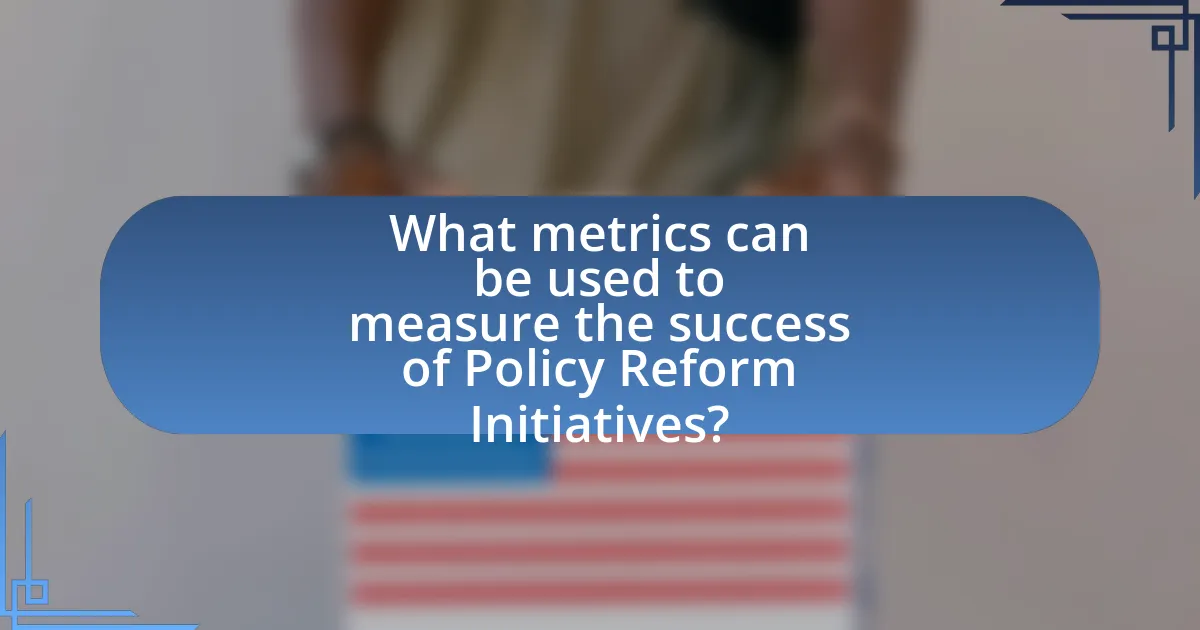
What metrics can be used to measure the success of Policy Reform Initiatives?
Metrics used to measure the success of Policy Reform Initiatives include quantitative indicators such as economic growth rates, employment rates, and public satisfaction surveys. Economic growth rates provide insight into the overall impact of reforms on the economy, while employment rates indicate job creation and labor market health. Public satisfaction surveys gauge citizen perceptions and acceptance of the reforms, reflecting their effectiveness in addressing community needs. Additionally, compliance rates with new regulations can serve as a metric, showing how well the reforms are being adopted by the target population. These metrics collectively offer a comprehensive view of the reforms’ success and areas for improvement.
How do qualitative metrics contribute to success measurement?
Qualitative metrics contribute to success measurement by providing insights into stakeholder perceptions, experiences, and satisfaction levels regarding policy reform initiatives. These metrics, such as interviews, focus groups, and open-ended survey responses, capture nuanced feedback that quantitative data may overlook. For instance, a study by the World Bank on public sector reforms highlighted that qualitative assessments revealed community concerns and expectations that were critical for tailoring effective policies. This demonstrates that qualitative metrics enhance understanding of the impact and effectiveness of reforms, ultimately guiding improvements and fostering stakeholder engagement.
What are examples of qualitative metrics in Policy Reform Initiatives?
Examples of qualitative metrics in Policy Reform Initiatives include stakeholder interviews, focus groups, and case studies. Stakeholder interviews provide insights into the perceptions and experiences of those affected by the policy changes, revealing the nuances of implementation and impact. Focus groups facilitate discussions among diverse participants, allowing for the exploration of attitudes and opinions regarding the reforms. Case studies offer in-depth analysis of specific instances of policy application, highlighting successes and challenges faced during implementation. These qualitative metrics are essential for understanding the broader implications and effectiveness of policy reforms beyond quantitative data.
How can stakeholder feedback be effectively gathered and analyzed?
Stakeholder feedback can be effectively gathered and analyzed through structured surveys, interviews, and focus groups. These methods allow for the collection of qualitative and quantitative data, ensuring a comprehensive understanding of stakeholder perspectives. For instance, a study by the International Association for Public Participation found that structured surveys can yield a response rate of up to 70%, providing a robust dataset for analysis. Additionally, employing data analysis tools such as sentiment analysis and thematic coding can help identify key trends and insights from the feedback, facilitating informed decision-making in policy reform initiatives.
What quantitative metrics are relevant for assessing success?
Quantitative metrics relevant for assessing success in policy reform initiatives include key performance indicators (KPIs) such as cost savings, implementation timelines, compliance rates, and stakeholder satisfaction scores. Cost savings measure the financial efficiency of the reform, while implementation timelines assess how quickly the reform is enacted. Compliance rates indicate the extent to which stakeholders adhere to new policies, and stakeholder satisfaction scores reflect the perceived effectiveness of the reform. These metrics provide concrete data that can be analyzed to evaluate the overall impact and effectiveness of policy changes.
Which data sources are most reliable for quantitative analysis?
Government databases are among the most reliable data sources for quantitative analysis. These databases, such as the U.S. Census Bureau, the Bureau of Labor Statistics, and the World Bank, provide comprehensive and systematically collected data that is often used for policy analysis. Their data is typically validated through rigorous methodologies and is regularly updated, ensuring accuracy and relevance. For instance, the U.S. Census Bureau conducts a decennial census and annual surveys that yield demographic and economic data critical for understanding population trends and economic conditions. This reliability is further supported by the transparency of their data collection processes and adherence to statistical standards.
How can statistical methods enhance the evaluation of Policy Reform Initiatives?
Statistical methods enhance the evaluation of Policy Reform Initiatives by providing rigorous frameworks for analyzing data, which leads to more accurate assessments of policy impacts. These methods, such as regression analysis and randomized controlled trials, allow researchers to isolate the effects of specific reforms from other influencing factors. For instance, a study published in the Journal of Policy Analysis and Management demonstrated that using statistical techniques improved the understanding of the economic impacts of healthcare reforms by quantifying changes in health outcomes and costs. By employing these methods, policymakers can make informed decisions based on empirical evidence, ultimately leading to more effective reforms.
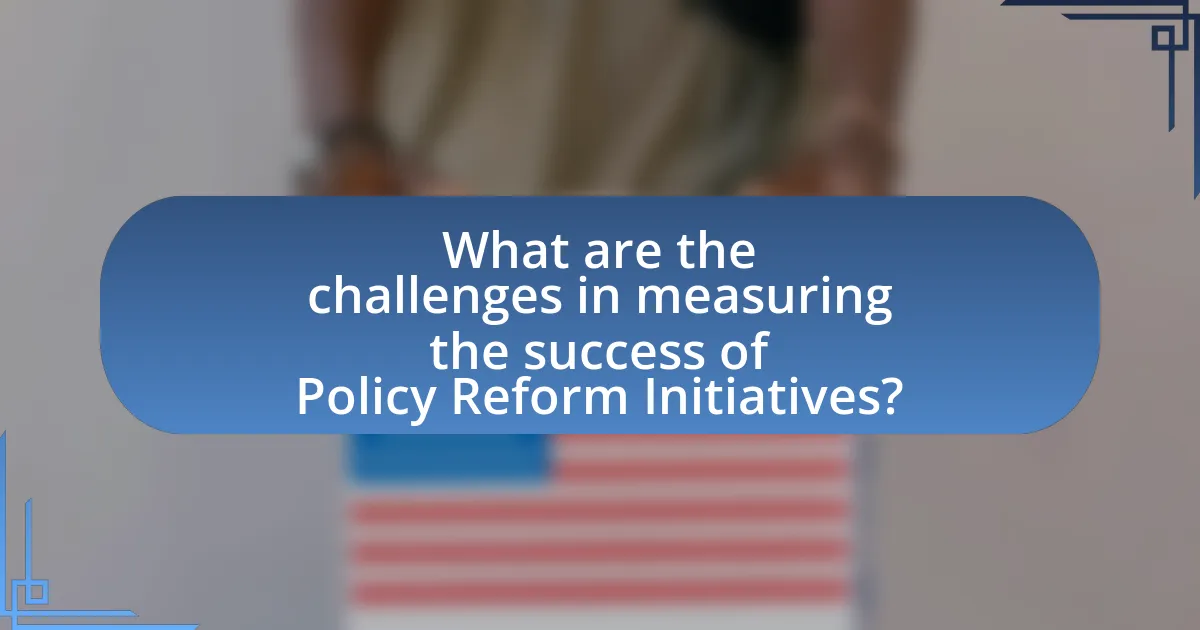
What are the challenges in measuring the success of Policy Reform Initiatives?
Measuring the success of Policy Reform Initiatives faces several challenges, including the complexity of defining success metrics, the influence of external factors, and the difficulty in isolating the effects of the reforms. Success metrics can vary widely, making it hard to establish a standardized measurement framework; for instance, economic indicators, social outcomes, and stakeholder satisfaction may all be relevant but differ in applicability. External factors, such as economic conditions or political changes, can significantly impact outcomes, complicating the attribution of success solely to the reforms. Additionally, isolating the effects of specific policy changes from other concurrent initiatives or societal trends is often problematic, as seen in studies where multiple reforms are implemented simultaneously, making it challenging to determine which had the most significant impact.
How do external factors complicate success measurement?
External factors complicate success measurement by introducing variables that can skew results and obscure the true impact of policy reform initiatives. For instance, economic conditions, social dynamics, and political climates can all influence outcomes independently of the reforms implemented. Research indicates that external economic shocks, such as recessions, can significantly alter the effectiveness of policy measures, making it difficult to attribute success or failure directly to the reforms themselves. Additionally, varying stakeholder interests and public perceptions can further complicate the assessment process, as they may lead to differing interpretations of what constitutes success.
What role do economic conditions play in evaluating success?
Economic conditions significantly influence the evaluation of success in policy reform initiatives. These conditions, such as GDP growth, unemployment rates, and inflation, provide a contextual framework that helps assess the effectiveness of reforms. For instance, a policy aimed at reducing unemployment may be deemed successful if the unemployment rate decreases in a favorable economic climate, while the same policy might be viewed as ineffective during a recession when job creation is inherently more challenging. Historical data shows that economic downturns can obscure the perceived success of reforms, as seen during the 2008 financial crisis, where many initiatives struggled to demonstrate positive outcomes despite their potential effectiveness. Thus, understanding the prevailing economic conditions is crucial for accurately measuring the success of policy reforms.
How can political changes affect the measurement process?
Political changes can significantly affect the measurement process by altering the priorities, methodologies, and metrics used to evaluate policy reform initiatives. For instance, a shift in government leadership may lead to new policy objectives, which in turn necessitates the development of different performance indicators to assess success. Historical examples include the transition from the Obama administration to the Trump administration in the United States, where changes in healthcare policy led to different metrics being prioritized, such as insurance coverage rates versus cost reduction. This demonstrates that political shifts can redefine what is measured and how success is quantified, impacting the overall effectiveness of policy evaluation.
What internal challenges might organizations face?
Organizations may face internal challenges such as resistance to change, lack of alignment among stakeholders, and insufficient resources. Resistance to change often stems from employees’ fear of the unknown or perceived threats to their job security, which can hinder the implementation of new policies. Lack of alignment among stakeholders can lead to conflicting priorities and goals, making it difficult to measure the success of policy reform initiatives effectively. Insufficient resources, including time, budget, and personnel, can limit an organization’s ability to execute and evaluate policy changes, ultimately impacting the overall success of reform efforts.
How can resource limitations hinder effective measurement?
Resource limitations can significantly hinder effective measurement by restricting the availability of necessary tools, personnel, and data. When organizations lack sufficient financial resources, they may not be able to invest in advanced measurement technologies or hire skilled analysts, leading to inadequate data collection and analysis. For instance, a study by the World Bank found that countries with limited budgets often struggle to implement comprehensive monitoring and evaluation frameworks, resulting in incomplete or biased data that fails to accurately reflect the impact of policy reforms. This lack of reliable data can ultimately impair decision-making and hinder the ability to assess the success of initiatives effectively.
What strategies can be employed to overcome measurement challenges?
To overcome measurement challenges in assessing the success of policy reform initiatives, employing mixed-method approaches is effective. Mixed-methods combine quantitative data, such as surveys and statistical analysis, with qualitative insights from interviews and focus groups, providing a comprehensive view of the impact. This strategy addresses the limitations of relying solely on one type of data, as quantitative measures may miss contextual nuances while qualitative data can lack generalizability. Research by Creswell and Plano Clark (2017) emphasizes that integrating both methods enhances the validity of findings, allowing for a more robust evaluation of policy outcomes.
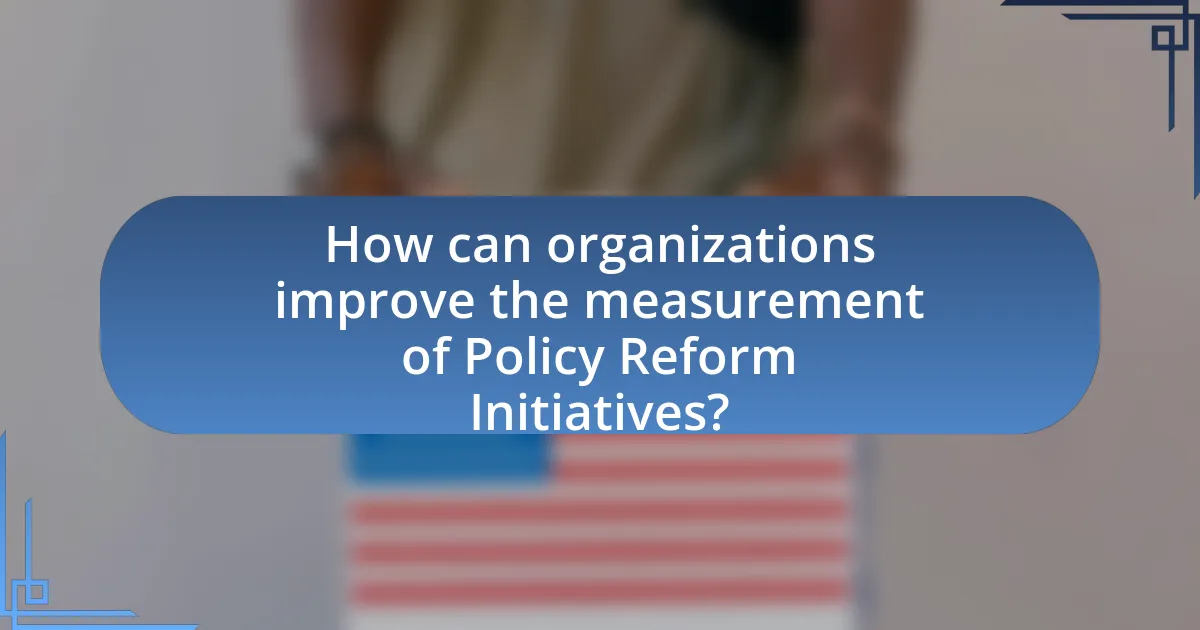
How can organizations improve the measurement of Policy Reform Initiatives?
Organizations can improve the measurement of Policy Reform Initiatives by implementing robust data collection methods and establishing clear performance indicators. By utilizing quantitative metrics such as economic impact assessments, social outcome evaluations, and stakeholder feedback, organizations can gain a comprehensive understanding of the initiatives’ effectiveness. For instance, a study by the World Bank on policy reforms in developing countries highlighted that systematic data collection led to a 30% increase in the accuracy of impact assessments. Additionally, employing mixed-method approaches that combine qualitative and quantitative data can provide deeper insights into the initiatives’ societal effects, thereby enhancing overall measurement accuracy.
What best practices should be adopted for effective measurement?
To achieve effective measurement of policy reform initiatives, it is essential to establish clear, specific objectives that align with desired outcomes. This clarity allows for the development of relevant metrics that accurately reflect progress and success. For instance, utilizing both qualitative and quantitative data enhances the comprehensiveness of the evaluation process, ensuring that multiple perspectives are considered. Additionally, employing a baseline measurement before implementing reforms provides a point of comparison, enabling the assessment of changes over time. Regularly reviewing and adjusting measurement strategies based on feedback and results further optimizes the evaluation process, ensuring that it remains relevant and effective. These practices are supported by research indicating that structured measurement frameworks lead to more informed decision-making and improved policy outcomes.
How can continuous feedback loops enhance measurement accuracy?
Continuous feedback loops enhance measurement accuracy by allowing for real-time adjustments based on ongoing data collection and analysis. This iterative process enables organizations to identify discrepancies and refine their measurement methods promptly, leading to more precise outcomes. For instance, in policy reform initiatives, continuous feedback can reveal the effectiveness of specific strategies, allowing policymakers to adapt their approaches based on measurable impacts, thereby increasing the reliability of the data collected. Studies have shown that organizations employing continuous feedback mechanisms report up to 30% improvement in measurement accuracy compared to those using static evaluation methods.
What role does technology play in improving measurement processes?
Technology significantly enhances measurement processes by enabling more accurate data collection, analysis, and reporting. Advanced tools such as data analytics software, sensors, and automated systems streamline the gathering of quantitative and qualitative data, reducing human error and increasing efficiency. For instance, the use of real-time data analytics allows policymakers to monitor the impact of reforms instantly, facilitating timely adjustments. Additionally, technologies like Geographic Information Systems (GIS) provide spatial analysis capabilities, which help visualize data trends and outcomes effectively. These advancements lead to more informed decision-making and improved accountability in policy reform initiatives.
What are common pitfalls to avoid in measuring success?
Common pitfalls to avoid in measuring success include relying solely on quantitative metrics, neglecting qualitative insights, and failing to establish clear objectives. Relying only on numbers can lead to a narrow understanding of success, as it may overlook important contextual factors. Neglecting qualitative insights can result in missing the nuances of stakeholder experiences and perceptions, which are crucial for a comprehensive evaluation. Additionally, without clear objectives, it becomes challenging to determine what success looks like, leading to misinterpretation of results. These pitfalls can undermine the effectiveness of measuring success in policy reform initiatives.
How can organizations ensure they are not biased in their evaluations?
Organizations can ensure they are not biased in their evaluations by implementing standardized evaluation criteria and utilizing diverse evaluation teams. Standardized criteria provide a consistent framework that minimizes subjective interpretations, while diverse teams bring varied perspectives that can identify and mitigate potential biases. Research indicates that organizations employing diverse teams in decision-making processes are 35% more likely to outperform their peers in terms of financial returns, as highlighted in a McKinsey report. This approach not only enhances the objectivity of evaluations but also fosters a culture of inclusivity and fairness.
What steps can be taken to ensure comprehensive data collection?
To ensure comprehensive data collection, organizations should implement a structured data collection framework that includes defining clear objectives, selecting appropriate data sources, and employing standardized data collection methods. Establishing clear objectives allows organizations to identify what data is necessary for measuring the success of policy reform initiatives. Selecting appropriate data sources, such as surveys, administrative records, and interviews, ensures that the data collected is relevant and reliable. Employing standardized methods, like using validated questionnaires or consistent data entry protocols, minimizes variability and enhances data quality. Research indicates that organizations that utilize structured frameworks for data collection achieve higher accuracy and completeness in their datasets, which is crucial for effective policy evaluation.
What practical tips can organizations implement for better measurement?
Organizations can implement specific strategies for better measurement by establishing clear, quantifiable objectives aligned with their policy reform initiatives. This involves defining key performance indicators (KPIs) that directly reflect the goals of the reform, such as tracking changes in public engagement or service delivery efficiency. Additionally, organizations should utilize data collection methods like surveys and analytics tools to gather relevant information consistently. For instance, a study by the Harvard Kennedy School emphasizes the importance of using both qualitative and quantitative data to assess the impact of policy changes effectively. By regularly reviewing and adjusting measurement frameworks based on feedback and results, organizations can ensure that their evaluation processes remain relevant and effective.
